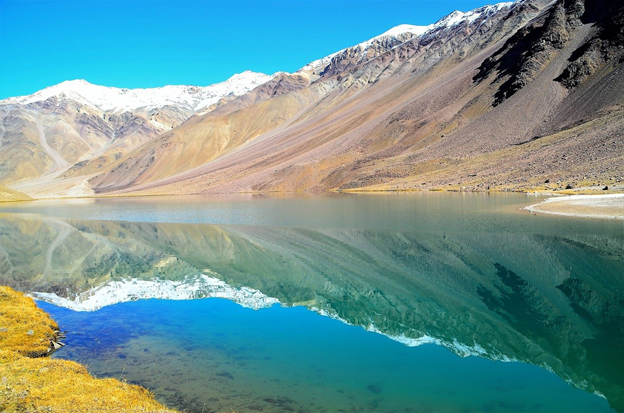Table of Contents
Ladakh has many natural wonders, but the Chadar Trek is the most precious gift bestowed upon this enchanted land. The trek is nothing but perseverance and survival – learning to survive in harsh environments at sub-zero temperatures, interacting with locals, and understanding their lifestyle, in one of the world’s least habitable regions.

Chadar is a word that refers to the thick sheet of ice that enslaves the ever-feral Zanskar river. During the winter, the civilization living beyond the valley’s canyons and ravines becomes engulfed in snow. And it is then that the ice on this river allows the residents of this remote valley to communicate with the rest of the world in the event of an emergency. Trekking may be considered a passing fad, but Chadar is not one of them. It’s the closest thing to walking on a glacier. The difficulty level, thrill-o-meter, and experience outperform all other treks you can think of. The prospect of completing a successful expedition on these snow boulders is unrivaled.
It’s not a journey; it’s a different kind of rejuvenation. And to be a part of it, extreme caution and preparation are required. The Frozen River Trek, a popular winter trek, is also one of the longest trekking trails in the Indian Himalayan region, covering 90 kilometers in eight chilly days. The Chadar Trek, like a walk to paradise, steals several trekkers’ dreams and becomes a part of their diary. The journey begins in Ladakh and ends in the snowbound villages of the Zanskar valley.
Reasons to go for Chadar Trek
,Chadar trek is unique in that it does not require much climbing due to the lack of elevation, but the extreme weather conditions, with temperatures dropping to -25 degrees Celsius, make it even more difficult.
View upon its white world: The Chadar Trek takes you away from civilization, where even adapting isn’t enough to survive, with its snow-capped mountains, ice sheet taming the raging river beneath, and biting cold winds.
Capture, upload, and brag: While this trek isn’t about flaunting and bragging about social media updates and living the moments and documenting the moments, still a little bragging won’t hurt.
Weather details
During the day, the temperature in Leh ranges between -10 and 0 degrees Celsius, depending on the weather. After sunset, the temperature begins to fall, and it can reach -25 degrees Celsius. A feather jacket, along with warm gloves and a warm hat, is a must-have not only for the trek but also for walking around Leh. When visiting the monastery, it is critical to remove one’s shoes and to wear a thick pair of warm socks.
Things To Carry for Chadar Trek
- A head torch
- Rain cover
- Gumboots
- Caps
- Towels and toilet paper
- A walking cane
- A daypack – at least 20-30 liters
- A bottle of water
- Waterproof linings on the backpack
- A spare pair of socks
- Thermals and fleece jackets
- A torch that emits light (with extra batteries)
- A light quilt or blanket
- Insect and mosquito repellent
- Windcheater that is waterproof
- Woollen Clothes
Best time to go for Chadar Trek
January and February; from the middle of January to the end of February, one can experience the raw thrill of walking on a frozen river. The trek usually takes 9-10 days and requires a minimum of 16-18 kilometers per day.
Level of difficulty
Extreme temperatures and a deteriorating trail are constant challenges on the journey. The trek is difficult for first-time trekkers because it is brutally honest. Though the trek was not intended for beginners at first, with proper preparation and guidance, it can now be completed by anyone seeking adventure. Make sure you choose your operator wisely, as they will either make or break your excursion. Don’t forget the health check which is mandatory before the Chadar Trek; without it you cannot begin with your trek.
Tips for Chadar Trek
A 75-kilometer journey to Zanskar valley includes 1,300 feet above sea level, a bone-chilling quaint setting, and a violent river ready to break the ground at any time. It truly does necessitate all of the preparation in the world of trekking, and preparation should start at least a month ahead of time.
If you’ve never done an acclimatization trek before, we recommend taking it more seriously this time. We recommend that you spend at least 2-3 days in northern India’s winter for the January trek. When you’re camping and hiking in subzero temperatures (-8 to -5 degrees Celsius on average), you’ll realize that cold is just a mental state.
Do’s And Don’ts For Chadar Trek
- Don’t give up at any point in time.
- Cast a shadow over the locals. They are well-versed in the best parts of the journey. Don’t do anything that the locals don’t.
- Accept the fact that you will fall and fail. You will slip on the ice and have to get back up – this will be the case for the first few days.
- Bring enough food and drinkable water; food may run out.
- Always keep a first-aid kit on hand. Bring your medications because the cuts and bruises are a welcome sight here.
- Do not cast doubt on weather forecasts.
- Maintain synchronization with MET records.
- Don’t skip a meal. The journey is strenuous, and you must remain alert even while sleeping.
- Do not disregard the Guide. Maintain strict adherence to him/her.
- Do not litter and, for obvious reasons, do not use soap in the waterfall.
- Avoid overstressing yourself.
